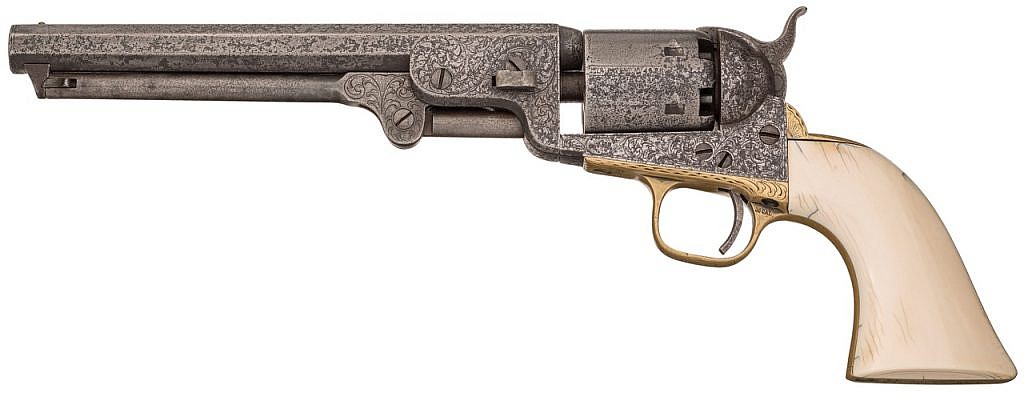
by Terry Wieland
One of the highlights of the mid-May Rock Island premier auction was a Colt 1851 Navy that belonged to one James Butler “Wild Bill” Hickok — one the most highly regarded, and certainly most storied, of the Old West gunfighters.
As with most, his reputation ranges from angelic to diabolical. In 1929, his home town of Homer, Illinois (now Troy Grove), where he was born in 1837, thought enough of him to erect a memorial, including a bust and plaque, in a public park — by coincidence, less than 60 miles from Rock Island.
It stresses Hickok’s service as a lawman, army scout, Pony Express guard, and even a spy for the Union during the Civil War. It does not mention his career as a gambler, or his full-time occupation with the guns he habitually wore, holster-less, tucked in his sash.
Usually, these were 1851 Navies, of which he was known to own at least two pair. Reliable sources maintain that Hickok preferred the Navies even after the advent of the cartridge-loaded 1873 Peacemaker.
Anyone who has handled an 1851 Navy can understand this: It’s the most well-balanced, easily handled, and accurate of the Colt percussion revolvers that appeared between 1847 and 1861, and Hickok was undeniably deadly with his.


In one of his most famous encounters, in Springfield, Missouri, in 1865, he killed gambler Davis Tutt. It was unquestionably self-defence, since several witnesses attested that Tutt emptied his revolver at Hickok across the town square, at which point Hickok calmly drew his Navy, levelled it on his arm and, at 80 yards, drilled Tutt through the heart. And this, with a cap’n’ball revolver having the power of a modern .380 ACP.
It’s almost 150 years since Hickok was murdered by Jack McCall, in the No. 10 Saloon in Deadwood, South Dakota, and historians are still trying to sort out fact from fiction. Jim Wilson, a former Texas sheriff and lifelong student of Old West history, says that Joseph Rosa’s books, including Wild Bill Hickok: Gunfighter, are the most factual and trustworthy, and he discounts older ones such as Triggernometry (1941) by Eugene Cunningham, as mostly hearsay.
“It’s significant that Hickok was highly regarded by the lawmen that came after — men like Bat Masterson and Wyatt Earp,” Jim told me. “That says a great deal.”
Hickok did not kill the most men, good or bad, of the notable Western gunfighters. It’s now generally conceded he dispatched about ten (a far cry from the hundred-plus claimed by some) and they, like Tutt, were trying to kill him.
By comparison, the body-count king, John Wesley Hardin (41 confirmed) was an out-and-out killer who took care of his enemies, real or perceived, by whatever means possible. Shooting in the back was as good a way as any, and better than most.
One fact is undisputed: Wild Bill Hickok was a bad man to cross. He met Hardin just one time, when he was town marshal in Abilene, Kansas.
“Hickok faced down Hardin,” Jim said, “And Hardin left town.”
Most credible first-hand accounts show Hickok as a gentleman — polite and well dressed, if a little flashy with his moustache and shoulder length hair — who did not go out of his way to look for trouble. A famous photograph shows him wearing a broad sash, tied at the side, with two ivory-handled 1851 Navies tucked in it. There was usually a Bowie knife about his person somewhere as well.
The revolver sold at Rock Island in May was not one of those, but of a different pair, engraved at the factory in a vine and scroll pattern. Its twin is in the Cody Museum in Wyoming.
After his death in 1876, Hickok’s belongings were auctioned to pay for his funeral, and the exact movements of his guns thereafter are difficult to document. The Rock Island gun is believed to have been sold in that auction.
It was obtained by a man who was in the area and he later sold it to a Minnesota man who kept it wrapped up in a trunk for many years. It then went to a gun dealer in Bloomington, who sold it in 1982 to Dr. Sterling Fenn. From him, it passed to the collection of Dr. Robert Azar, and thence to Rock Island. When it was taken out of the old trunk, it was found to be still loaded. (It no longer is.)
Imagine, however, the value of a gun loaded by Hickok’s own hand.
It is serial number 204685; its mate in the museum in 204672. Both were manufactured in 1868, a year after the famous photograph, and close enough together to have been engraved at the same time, and presented to Hickok by person or persons unknown
Today, the original finish has a somewhat mottled look from shallow pitting, but it is strangely appealing.
It came up for auction on the third day (lot #3116), estimated to sell for anywhere from $140,000 to $225,000. When the dust settled, it brought a realized price (hammer price plus buyer’s premium) of $616,875.
In the brief viewing period before the auction began that morning, I donned a pair of white cotton gloves and was handed the Colt to examine. It had the look and feel of a gun that had been gainfully employed but well cared for. It felt, well, deadly. Let’s leave it at that.
As Wieland was holding Hickok’s gun, he felt a hand on his shoulder and a voice murmured, “You need that, son…” But when he looked around, there was no one there.
